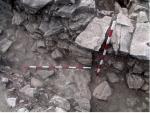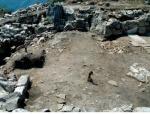Summary (English)
EXPLORATIONS NEAR ETROPOLE (Aneta Petrova – anp@mail.bg, Boyan Dumanov) Late Antique surrounding wall documented in Sondage 14 made a turn to the south. The building was most probably constructed during the Ottoman period. The finds were mostly from the Ottoman period: sherds, an adze, a key, a latch and fragments from tobacco pipes (17th – 18th centuries). A destroyed church was explored in the eastern side of the site. It was 10 m long and 5 m wide, built of roughly-cut stones bonded with mortar. The church had two construction periods: during the first one a nave, 4.80 m long, was built and during the second, a narthex with entrances from the west and the north, 4 m long, was added. The roof was probably covered with stone slabs and roof-tiles in the apse. The lowest part of frescoes was documented on the southern wall and in the northwestern corner. Fallen fragments from frescoes were discovered. Azurite was used for the blue color, sienna for the yellow-brown and lime with lead for the white. Finds mostly from the Ottoman period (pottery and a bone pin) were found inside the church and around it, plus a few fragments from Late Antique glass icon-lamps. A para, minted in Constantinople in 1808/1809 during Sultan Mahmud II, and an akçe of the end of the 16th century were found in the church. The church was probably built at the end of the 16th – beginning of the 17th century. The finds discovered during the explorations of the buildings in Sondages 5 and 7 included Late Antique sherds, including from dolia, fragments from Late Antique glass vessels and two folles, minted in Constantinople in the period AD 538 – 565 during the reign of Justinian I. Material from the Ottoman period prevailed in the upper layers of the sondages: sherds, a tobacco pipe and a coin minted in Mazar, Egypt, in 1730/1731 during Sultan Mahmud I. The animal bones discovered were from goats and sheep, ox, pigs, birds and deer.
- Boyan Dumanov - Department of Archaeology, New Bulgarian University
- Aneta Petrova - Department of Archaeology, Sofia University St. Kliment Ohridski
Director
Team
Research Body
- New Bulgarian University






![Download [PDF]](/excavation/skins/fasti/images/results/download_sml.png)

